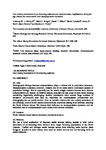Intercolony movement of pre-breeding seabirds over oceanic scales: implications of cryptic age-classes for conservation and metapopulation dynamics
| dc.contributor.author | Bicknell, AWJ | |
| dc.contributor.author | Knight, ME | |
| dc.contributor.author | Bilton, DT | |
| dc.contributor.author | Campbell, M | |
| dc.contributor.author | Reid, JB | |
| dc.contributor.author | Newton, J | |
| dc.contributor.author | Votier, SC | |
| dc.date.accessioned | 2018-08-13T13:44:09Z | |
| dc.date.available | 2018-08-13T13:44:09Z | |
| dc.date.issued | 2014-02 | |
| dc.identifier.issn | 1366-9516 | |
| dc.identifier.issn | 1472-4642 | |
| dc.identifier.uri | http://hdl.handle.net/10026.1/12069 | |
| dc.description.abstract |
<jats:title>Abstract</jats:title><jats:sec><jats:title>Aim</jats:title><jats:p>Demographic linkage between subpopulations plays a critical role in population processes. Metapopulation dynamics, however, remains one of the most poorly understood aspects of population biology. This is especially true for small, pelagic seabirds because their discrete subpopulations are located on offshore islands, separated by vast areas of open ocean, making monitoring logistically challenging. Seabird populations often contain large numbers of immature pre‐breeders that may be important for subpopulation connectivity and demography, but are poorly studied. Here we provide evidence for intercolony movement of pre‐breeding <jats:styled-content style="fixed-case">L</jats:styled-content>each's storm‐petrels <jats:italic><jats:styled-content style="fixed-case">O</jats:styled-content>ceanodroma leucorhoa</jats:italic> among three colonies spanning the <jats:styled-content style="fixed-case">N</jats:styled-content>orth <jats:styled-content style="fixed-case">A</jats:styled-content>tlantic <jats:styled-content style="fixed-case">O</jats:styled-content>cean. We discuss their influence on metapopulation dynamics and the extinction risk of a subpopulation under threat from extreme predation.</jats:p></jats:sec><jats:sec><jats:title>Location</jats:title><jats:p>North <jats:styled-content style="fixed-case">A</jats:styled-content>tlantic <jats:styled-content style="fixed-case">O</jats:styled-content>cean <jats:styled-content style="fixed-case">I</jats:styled-content>slands (<jats:styled-content style="fixed-case">S</jats:styled-content>cotland, <jats:styled-content style="fixed-case">C</jats:styled-content>anada & <jats:styled-content style="fixed-case">I</jats:styled-content>celand).</jats:p></jats:sec><jats:sec><jats:title>Methods</jats:title><jats:p>We use a novel application of <jats:styled-content style="fixed-case">B</jats:styled-content>ayesian stable isotope mixing models to infer recent movement of pre‐breeding birds between three major breeding populations in the <jats:styled-content style="fixed-case">N</jats:styled-content>orth <jats:styled-content style="fixed-case">A</jats:styled-content>tlantic. Carbon and nitrogen stable isotope values from breeding birds (central place foragers) sampled at each colony were used as model sources and pre‐breeding birds as model mixtures.</jats:p></jats:sec><jats:sec><jats:title>Results</jats:title><jats:p>Of 134 pre‐breeding Leach's storm‐petrels sampled at three colonies across the <jats:styled-content style="fixed-case">N</jats:styled-content>orth <jats:styled-content style="fixed-case">A</jats:styled-content>tlantic, five had isotope mixing model estimates dissimilar (< 25%) to their colony of capture and were instead isotopically similar to another breeding region. Nineteen further pre‐breeders had highly mixed signatures (< 50% for the colony of capture), indicating possible recent movement between colonies.</jats:p></jats:sec><jats:sec><jats:title>Main conclusions</jats:title><jats:p>Our findings provide evidence for interpopulation connectivity of pre‐breeding <jats:styled-content style="fixed-case">L</jats:styled-content>each's storm‐petrels among colonies spanning the <jats:styled-content style="fixed-case">N</jats:styled-content>orth <jats:styled-content style="fixed-case">A</jats:styled-content>tlantic. These results highlight the significance of cryptic young age‐classes in metapopulation dynamics and the demographic processes. Moreover, they provide us with a better understanding of how one subpopulation remains extant, despite experiencing extreme predation rates.</jats:p></jats:sec> | |
| dc.format.extent | 160-168 | |
| dc.language | en | |
| dc.language.iso | en | |
| dc.publisher | Wiley | |
| dc.subject | Dispersal | |
| dc.subject | extinction risk | |
| dc.subject | Leach's storm-petrel | |
| dc.subject | metapopulation | |
| dc.subject | predation | |
| dc.subject | stable isotopes | |
| dc.title | Intercolony movement of pre-breeding seabirds over oceanic scales: implications of cryptic age-classes for conservation and metapopulation dynamics | |
| dc.type | journal-article | |
| dc.type | Article | |
| plymouth.author-url | http://gateway.webofknowledge.com/gateway/Gateway.cgi?GWVersion=2&SrcApp=PARTNER_APP&SrcAuth=LinksAMR&KeyUT=WOS:000329509900001&DestLinkType=FullRecord&DestApp=ALL_WOS&UsrCustomerID=11bb513d99f797142bcfeffcc58ea008 | |
| plymouth.issue | 2 | |
| plymouth.volume | 20 | |
| plymouth.publication-status | Published | |
| plymouth.journal | DIVERSITY AND DISTRIBUTIONS | |
| dc.identifier.doi | 10.1111/ddi.12137 | |
| plymouth.organisational-group | /Plymouth | |
| plymouth.organisational-group | /Plymouth/Faculty of Science and Engineering | |
| plymouth.organisational-group | /Plymouth/Faculty of Science and Engineering/School of Biological and Marine Sciences | |
| plymouth.organisational-group | /Plymouth/REF 2021 Researchers by UoA | |
| plymouth.organisational-group | /Plymouth/REF 2021 Researchers by UoA/UoA06 Agriculture, Veterinary and Food Science | |
| plymouth.organisational-group | /Plymouth/REF 2021 Researchers by UoA/UoA07 Earth Systems and Environmental Sciences | |
| plymouth.organisational-group | /Plymouth/Research Groups | |
| plymouth.organisational-group | /Plymouth/Research Groups/Marine Institute | |
| plymouth.organisational-group | /Plymouth/Users by role | |
| plymouth.organisational-group | /Plymouth/Users by role/Academics | |
| dcterms.dateAccepted | 2013-10-31 | |
| dc.identifier.eissn | 1472-4642 | |
| dc.rights.embargoperiod | Not known | |
| rioxxterms.versionofrecord | 10.1111/ddi.12137 | |
| rioxxterms.licenseref.uri | http://www.rioxx.net/licenses/all-rights-reserved | |
| rioxxterms.licenseref.startdate | 2014-02 | |
| rioxxterms.type | Journal Article/Review |


